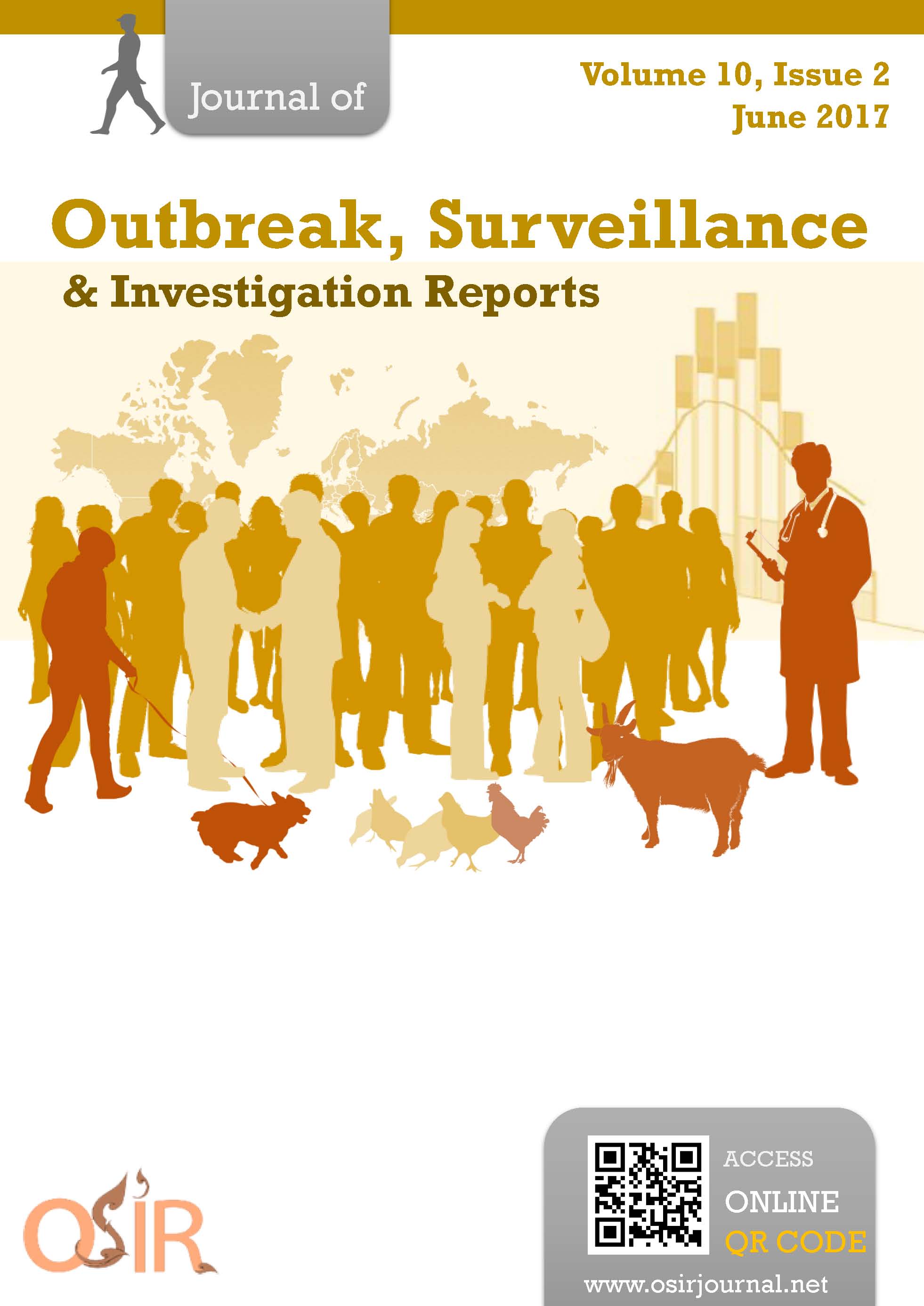Clinical Profile and Circulating Dengue Virus Serotype among Adults Admitted to Yangon General Hospital during the 2015 Dengue Outbreak
DOI:
https://doi.org/10.59096/osir.v10i2.263142Keywords:
dengue outbreak, adult dengue, dengue virus serotypes, MyanmarAbstract
During the 2015 dengue season in Myanmar, there was an unusual increase in occurrence of adult dengue cases. To identify circulating serotypes and clinical profiles of adult dengue during the outbreak, blood samples were collected from clinically suspected dengue patients admitted to Yangon General Hospital during July to September 2015. Among 75 samples tested for NS1Ag and immunoglobulins IgG/IgM, 33 (44.0%) were serologically confirmed, including 11 (33.3%) primary and 22 (66.7%) secondary infection. The mean age was 20.8 years (range 13-49 years). There were 77.3% (17/22) of secondary infection and 45.5% (5/11) of primary infection developed into severe types of dengue infection. Bleeding manifestations occurred in 13 (39.4%) patients, with gastrointestinal bleeding as the most common form. Out of the 33 samples serologically confirmed, dengue virus was detected in six (18.2%) and all were serotype 1 which has been the predominant serotype in Myanmar since 2009. These findings contributed information on the recent adult dengue outbreak and aided to bridge the knowledge gap concerning adult dengue in Myanmar. Further molecular research should be conducted on serotype negative samples.
References
World Health Organization and the Special Programme for Research and Training in Tropical Diseases. Dengue: guidelines for diagnosis, treatment, prevention and control. New ed. Geneva: World Health Organization; 2009. p. 137-44.
Bhatt S, Gething PW, Brady OJ, Messina JP, Farlow AW, Moyes CL, et al. The global distribution and burden of dengue. Nature. 2013 Apr 25;496(7446):504-7. Epub 2013 Apr 7.
Beatty M. Global burden of dengue. 2015 [cited 2015 Jan 15]. <http://www.denguewatch.org>
Guha-Sapir D, Schimmer B. Dengue fever: new paradigms for a changing epidemiology. Emerg Themes Epidemiol. 2005 Mar 2;2(1):1.
Bhatia R, Dash AP and Sunyoto T. Changing epidemiology of dengue in South-East Asia. WHO South-East Asia Journal of Public Health. 2013; 2(1): 23-27.
Goh KT. Dengue-a re-emerging infectious disease in Singapore. Ann Acad Med Singapore. 1997 Sep;26(5):664-70.
Rahman M, Rahman K, Siddque AK, Shoma S, Kamal AHM, Ali KS, et al. First outbreak of dengue hemorrhagic fever, Bangladesh. Emerg Infect Dis. 2002;8(7):738-40.
Malavige GN, Velathanthiri VG, Wijewickrama ES, Fernando S, Jayaratne SD, Aaskov J, et al. Patterns of disease among adults hospitalized with dengue infections. QJM. 2006 May;99(5):299-305. Epub 2006 Apr 7.
Thein S, Aung MM, Shwe TN, Aye M, Zaw A, Aye K, et al. Risk factors in dengue shock syndrome. Am J Trop Med Hyg. 1997 May;56(5):566-72.
Myanmar. Department of Medical Research (Lower Myanmar). Ministry of Health. Annual report 2014. Yangon: Department of Medical Research (Lower Myanmar); 2014.
Thein S, Nwe MT, Min H, Sein AK, Tint K, Nyein K, et al. An outbreak of fever with haemorrhagic manifestations in children and young adults in Lashio Township, 1994. Myan J Cur Med Pract. 1998;2:203-6.
Oo AS, Myint MK, Win AS, Khaing MTT, Maw AM, Aung Y, et al. Clinical profile of dengue hemorrhagic fever in adults in Pyin Oo Lwin Hospital in 2009. The Myanmar Health Sciences Research Journal. 2013;24 (1):1-6.
World Health Organization. Dengue hemorrhagic fever: diagnosis, treatment and control. 1997 [cited 2016 Jan 23]. <http://apps.who.int/iris/bitstream/10665/41988/1/9241545003_eng.pdf>
Seah CLK, Chow VTK, Tan HC, Chan YC. Rapid, single-step RT-PCR typing of dengue viruses using five NS3 gene primers. J Virol Methods. 1995;51(2-3):193-200.
World Health Organization. Dengue and severe dengue. 2016 [cited 2016 Jan 23]. <http://www.who.int/mediacentre/factsheets/fs117/en/>
Wichmann O, Hongsiriwon S, Bowonwatanuwong C, Chotivanich K, Sukthana Y, Pukrittayakamee S. Risk factors and clinical features associated with severe dengue infections in adults and children during the 2001 epidemic in Chonburi, Thailand. Trop Med Int Health. 2004 Sep;9(9):1022-9.
Thein S, Mauk KKA. Dengue hemorrhagic fever in Adults. Myanmar Journal of Current Medical Practice. 2010;14:7-8.
Shepard DS, Undurraga EA, Halasa YA. Economic and disease burden of dengue in Southeast Asia. PLoS Negl Trop Dis. 2013;7 (2):e2055. Epub 2013 Feb 21.
Halstead SB, Nimmannitya S, Yamarat C, Russel PK. Hemorhagic fever in Thailand; recent knowledge regarding etiology. Jpn J Med Sci Biol. 1967 Dec;20 Suppl:96-103.
Myat TW. Inter-host and intra-host genetic diversity of dengue virus strains in children with dengue infection [thesis]. Yangon: University of Medicine 2, Yangon. 2013.
Fried JR, Gibbons RV, Kalayanarooj S, Thomas SJ, Srikiatkhachorn A, Yoon IK, et al. Serotype-specific differences in the risk of dengue hemorrhagic fever: an analysis of data collected in Bangkok, Thailand from 1994 to 2006. PLoS Negl Trop Dis. 2010 Mar 2;4(3):e617.
Pandey BD, Nabeshima T, Pandey K, Rajendra SP, Shah Y, Adhikari BR, et al. First isolation of dengue virus from the 2010 epidemic in Nepal. Trop Med Health. 2013 Sep;41(3):103-11.
Herriman R. Asia dengue fever update: Philippines, Malaysia, Thailand, Vietnam and Singapore. 2015 Jul 3 [cited 2016 June 20]. <http://outbreaknewstoday.com/asia-dengue-fever-update-philippines-malaysia-thailand-vietnam-and-singapore-16816/>
Downloads
Published
How to Cite
Issue
Section
License
Copyright (c) 2023 Outbreak, Surveillance, Investigation & Response (OSIR) Journal

This work is licensed under a Creative Commons Attribution-NonCommercial-NoDerivatives 4.0 International License.









